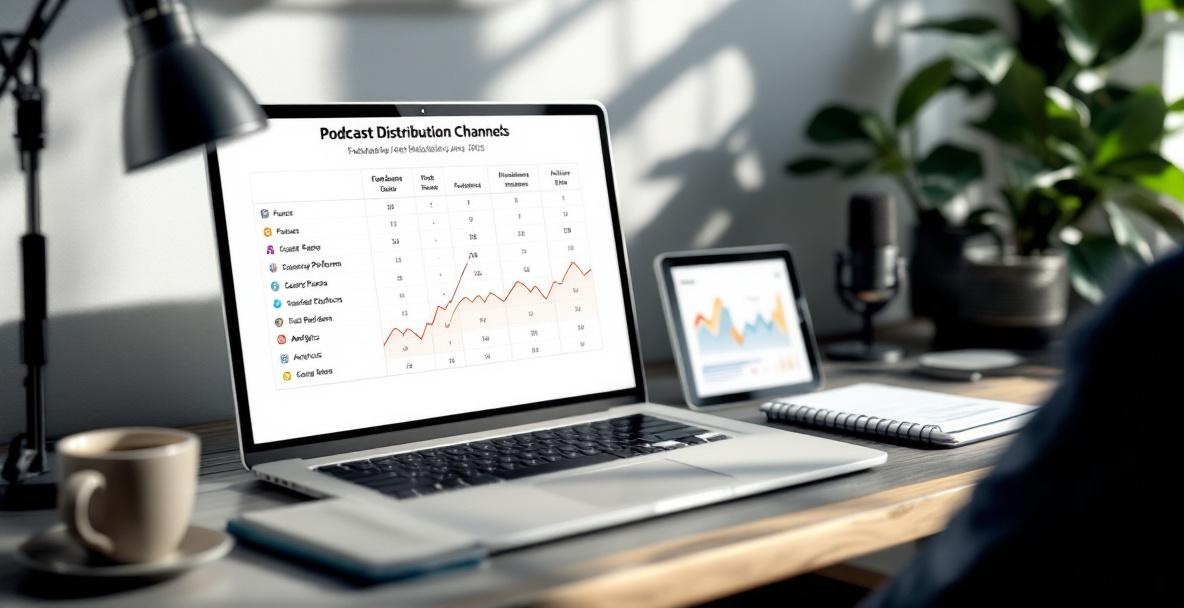The podcast world has changed dramatically over the years, and picking the right platform can turn your show from unnoticed to a hit. Choosing the right distribution channels can mean the difference between a quiet start and explosive growth. In 2025, there are more options than ever, each offering its own mix of technical features and unique audiences. When you decide carefully where to share your episodes, you're setting the stage for success.
Why Your Podcast’s Reach Depends on Where It Lands

Podcasts are booming this year, and listener numbers are reaching record highs. According to recent industry research from GII Research, what once was a niche interest is now a favorite for millions around the globe. Podcast growth is immense, and this surge brings both new opportunities and tough challenges for creators.
The simple act of uploading has turned into a major marketing decision that affects discoverability, audience growth, and earnings. With listeners exploring multiple shows on various platforms, being in the right place is more essential than ever. Your choice of platforms can make your content easy to find or nearly invisible.
Taking a smart, multi-channel approach now beats the old method of posting to one or two big names and hoping for the best. Today’s top podcasters understand that every channel plays its part in a larger growth strategy. Relying on just one method simply does not cut it anymore when every decision counts.
Fresh Faces in Podcast Distribution
The podcast scene in 2025 has welcomed several fresh faces that are shaking up traditional methods with creative new ways to deliver content and engage audiences. These new platforms come with features designed to fix long-standing issues with discovery and keeping listeners hooked.
Sites that mix live conversation with on-demand listening are changing the game. These social audio platforms combine the excitement of live talk with the comfort of listening at your own pace, offering a rich way to interact with your audience. Building a community is easier when you have tools that make conversations personal and engaging.
Niche channels that focus on specific interests-from business insights to creative stories-are gaining traction. These platforms speak directly to groups with a shared passion, often leading to better sponsor results and stronger listener loyalty. When your content fits a specific niche, these options can drive a deeper connection.
Smart discovery platforms use clever algorithms to match your show with the right listeners. Instead of lumping everything into broad categories, they analyze detailed preferences to ensure your unique content gets the attention it deserves. This approach can help hidden gems shine brightly.
Old Favorites: Do They Still Hold the Power?
Even with all the new players entering the scene, the well-known platforms hold on to a lot of power in 2025. Their huge audiences, strong brand names, and ongoing improvements keep them central to any strong podcast strategy. Big names still matter when it comes to being taken seriously.
Apple Podcasts continues to be a go-to choice, thanks to its vast directory and smooth integration with the Apple ecosystem. Its curated selections still spark listener interest and add credibility to your show, and recent upgrades in creator tools and analytics keep it competitive.
Spotify remains a favorite by blending music streaming with a growing catalog of podcasts. Its smart recommendation engine draws listeners based on their habits across different audio content, making it easy to discover new shows. Their focus on exclusive content and advanced creator tools makes it hard to ignore.
YouTube is becoming a top destination for podcasts, thanks to enhanced audio features and an unrivaled search system. Its ability to blend visuals with audio makes it ideal for creators looking to showcase more than just sound, and its powerful algorithms help reach a wider audience.
Amazon Music and Audible use their strong ties with the larger Amazon ecosystem to offer extra benefits like smart speaker integration and cross-promotion opportunities. These unique advantages add value to your overall distribution mix.
What’s Changing in Podcast Distribution This Year?

Podcast distribution isn’t what it used to be. New technologies, fresh ways of listening, and ever-evolving platform features mean that podcasters have to think differently about how they connect with audiences. Staying updated is a must if you want to be heard.
One exciting change is the rise of decentralized networks that let you keep full control of your work while enjoying benefits like shared revenue and broader reach. Built on blockchain technology, these networks offer transparent earnings and a stronger sense of ownership-perfect if you value independence.
Optimizing your show for voice assistants has become vital as smart devices become common in every home. Podcasts that are tuned for voice search enjoy a serious boost in discoverability when listeners use natural language to ask for recommendations. This change makes it easier for fans to find exactly what they’re looking for.
Modern analytics tools now give you a complete view of how listeners move from one channel to another. With this holistic data, you can fine-tune your content and marketing efforts to keep your audience engaged. Data-driven decisions help you maximize every episode’s potential.
How to Reach the Right Listeners
No matter how good your show is, connecting with the right audience is the real measure of success. Knowing where your future listeners spend their time is the foundation for a smart distribution strategy.
Understanding Who’s Listening
Each platform attracts its own mix of listeners. In 2025, these differences are clearer than ever, with every channel highlighting its own strengths. Knowing your audience can help you decide which platform feels like home for your podcast.
Younger fans tend to find new shows through social media and apps they use every day. Pew Research Center's latest audio consumption data shows that they prefer smooth and connected digital experiences. Platforms that emphasize easy sharing and social features work best for this crowd.
Busy professionals look for efficiency when it comes to finding content. They favor channels that make it easy to sift through shows and get straight to what matters, like transcripts and easy-to-use navigational features. This helps them integrate podcast listening into a hectic schedule.
Communities built around specific interests also prove powerful. Special channels with a targeted focus may have smaller audiences, but they inspire high engagement and loyalty. If your podcast speaks to a niche, these platforms could be the perfect match.
Listeners from around the world add another dimension. Some platforms have a strong local presence, so understanding regional favorites is essential if you aim to expand globally. Tailoring your strategy to fit regional trends can make a big difference.
Using Data to Guide Your Choices
Making well-informed decisions starts with solid data about listener behavior. Modern analytics give you the tools to see exactly how people interact with your content across platforms. Smart insights can lead your podcast to the best channels.
Tools that combine data from every channel help you build a clear picture of engagement. Instead of relying on download counts alone, you learn where your most loyal listeners are turning up. This unified view is key for growth.
Tracking the full journey of your listeners has never been easier. By understanding how people find you and what makes them come back, you can polish your content and adjust your strategy over time. The more you know, the better you can serve your audience.
Metrics now go beyond the basic play count. They include details like how many listeners finish an episode, come back again, or share your content with friends. These numbers show where your efforts hit the mark.
New methods that track movement across channels reveal how different platforms work together to boost your audience. This sort of cross-platform data is invaluable when deciding where to invest your time and energy.
Deciding on the Best Platforms for Your Podcast

Now that you know who your listeners are and how the landscape is changing, it’s time to evaluate each option. Your final choice will depend on both the cool features the platform offers and its overall business benefits.
Key Features and How They Feel to Use
Every platform comes with its own set of tools that can help-or sometimes hinder-your show. Think about how each channel makes it easy for listeners to find your episodes and whether its features help your content shine. Great discoverability is essential for growth.
How your episodes look and feel matters a lot too. Options for show notes, chapter markers, and embedded links let you add more depth to your content. Platforms that offer these extras give you a chance to tell your story more fully and keep your audience interested.
Money-making options vary widely. Some platforms have in-built ads, while others use subscription or sponsorship models. It’s important to align these features with your revenue goals, so you can grow your show while keeping it profitable.
Finally, the listening experience itself can make or break your success. Features like playback speed, offline mode, and simple queue management add up to a smoother, more enjoyable experience. Even if discoverability isn’t their strongest suit, platforms that offer a top-notch experience can turn casual visitors into loyal fans.
Weighing the Costs and Benefits
Your decision is not just about cool features; it’s also about balancing cost and gain. Some platforms charge fees or take a cut of your earnings, while others may offer free access. Smart budgeting is key to choosing the right option for your current needs and future plans.
When you decide, compare the immediate expenses with the potential for growing your audience. Sometimes spending a little more upfront can pay off later with better visibility and stronger engagement. Meanwhile, free channels might offer a no-risk way to dip your toes into new markets.
Exclusivity can complicate things. While some exclusive deals offer extra perks, they might also limit how far your show can spread. Spreading your episodes across several channels often gives you a broader reach and more flexibility in the long run.
Lastly, check how well each platform mixes with your existing marketing tools. When distribution methods work smoothly with your current setup, it saves time and clears the way for smarter decisions. Integration is key to a streamlined podcast strategy.
Practical Tips for Rolling Out Your Distribution Strategy

After you’ve chosen your channels, the next step is to put your plan into action. It takes solid technical skills and smart organization, but the rewards are worth every bit of effort.
Getting Your Podcast Live on Several Channels
When launching your show on multiple platforms, keeping your branding consistent is vital. Every listener should instantly recognize your podcast, no matter where they tune in. Make sure your artwork, descriptions, and episode titles feel familiar across each channel. Strong branding builds trust and keeps your show memorable.
Taking the time to optimize your details for each channel also makes a big difference. Every platform categorizes content slightly differently, so adjusting your descriptions, tags, and categories can help your podcast stand out. Simple tweaks can boost your visibility without changing what your show is all about.
Keeping your release schedule on track is another important step. Using scheduling tools ensures that your episodes drop simultaneously on all channels, which is especially critical for time-sensitive content. Consistent scheduling creates a routine that your audience can count on.
Automation tools can also lighten the workload. These handy systems let you upload your episode once and then format it perfectly for each channel. For busy podcasters, this streamlined process is a major time-saver and keeps everything running smoothly.
Steering Clear of Pitfalls
Even experienced podcasters can stumble when setting up on multiple platforms. Small mistakes can slow you down, so it’s important to know what to watch out for and address them early.
One common misstep is skipping the verification process on new platforms. Without these steps, your show might not go live on time, which can hurt your credibility. Make sure you complete verification well before your launch.
Another pitfall is changing the structure of your episodes from one platform to another. Keeping your acceptably similar intro, ad spots, and calls to action helps build a consistent listening habit. Consistency reassures your audience and makes your show feel professional.
Ignoring each platform’s community guidelines can also create problems. Take time to learn each channel’s rules about content, copyright, and advertising so you can avoid any unwanted surprises.
Finally, don’t ignore performance data. Without regular checks on metrics, you might miss out on valuable insights about which channels are performing best. Tracking performance closely will help tweak your strategy and boost your growth over time.
Wrapping Up: Your Next Moves in Podcasting
Looking Back and Moving Forward
The podcast scene in 2025 is full of possibilities if you choose your channels wisely. Your distribution strategy is always evolving, shaped by new data, platform updates, and your creative vision. Plan smartly and be ready to adjust as your audience grows and changes.
Start by understanding your listeners and match them with the right platforms. Make choices that fit both your content style and your budget, and keep the process consistent across channels. Regularly check your data and feel free to experiment-it’s the key to staying ahead.
Connect and Grow Your Community
At the end of the day, it’s all about forming real connections with your listeners. Every step, from choosing a channel to optimizing your metadata, should help forge deeper bonds. Meaningful engagement turns casual listeners into loyal fans.
Make it easy for your audience to follow you wherever they listen and to share episodes with friends. When your listeners find it simple to connect, they will help spread the word, driving growth through real recommendations. Always listen to their feedback-it might lead to fresh ideas and new opportunities.
Ready to transform your podcast distribution strategy and connect with more engaged listeners? Castee offers the comprehensive tools you need to optimize your podcast's presence across multiple platforms, track performance with unified analytics, and build stronger connections with your audience. Visit us today to discover how our end-to-end podcast marketing solution can amplify your voice and grow your podcast community.
Leave a Reply